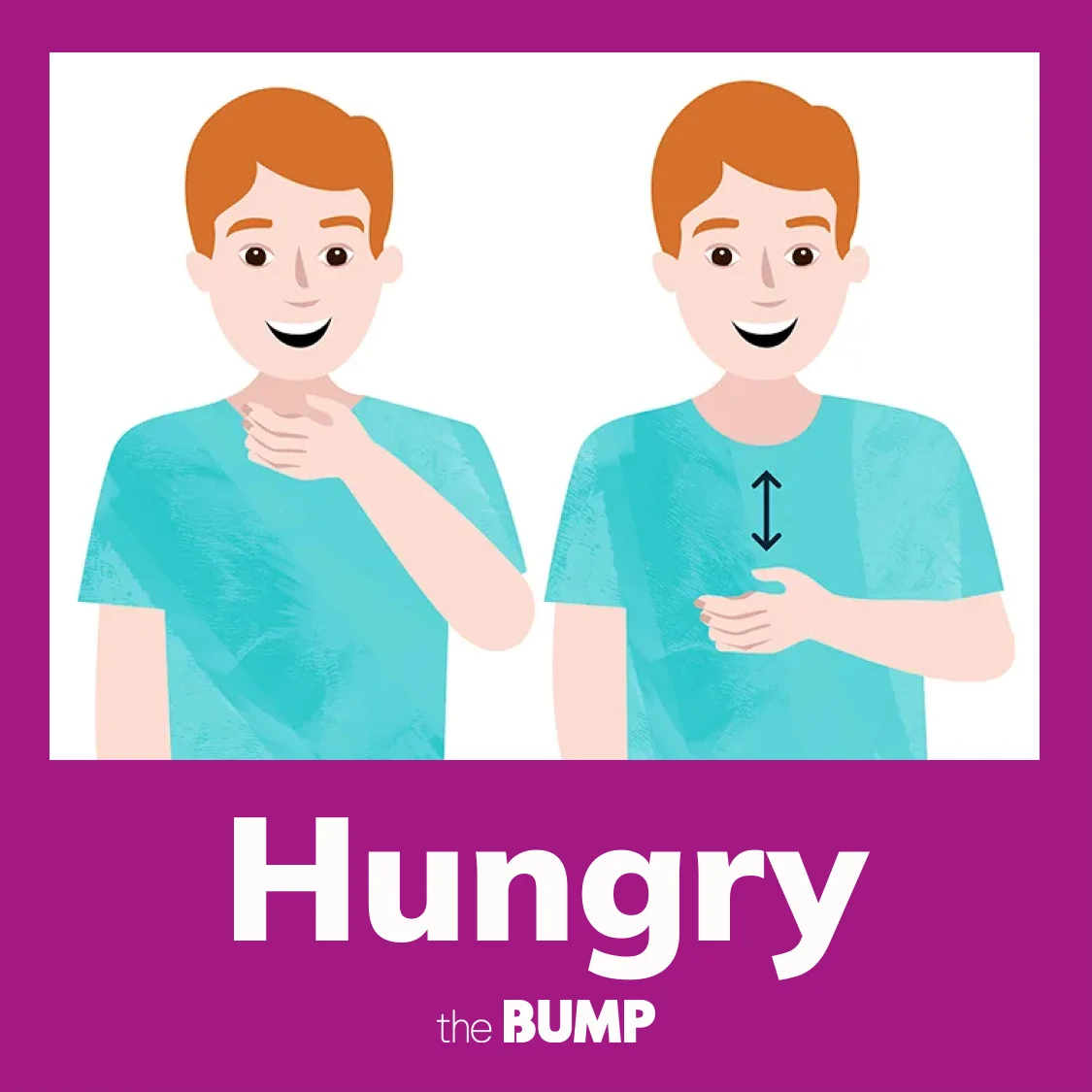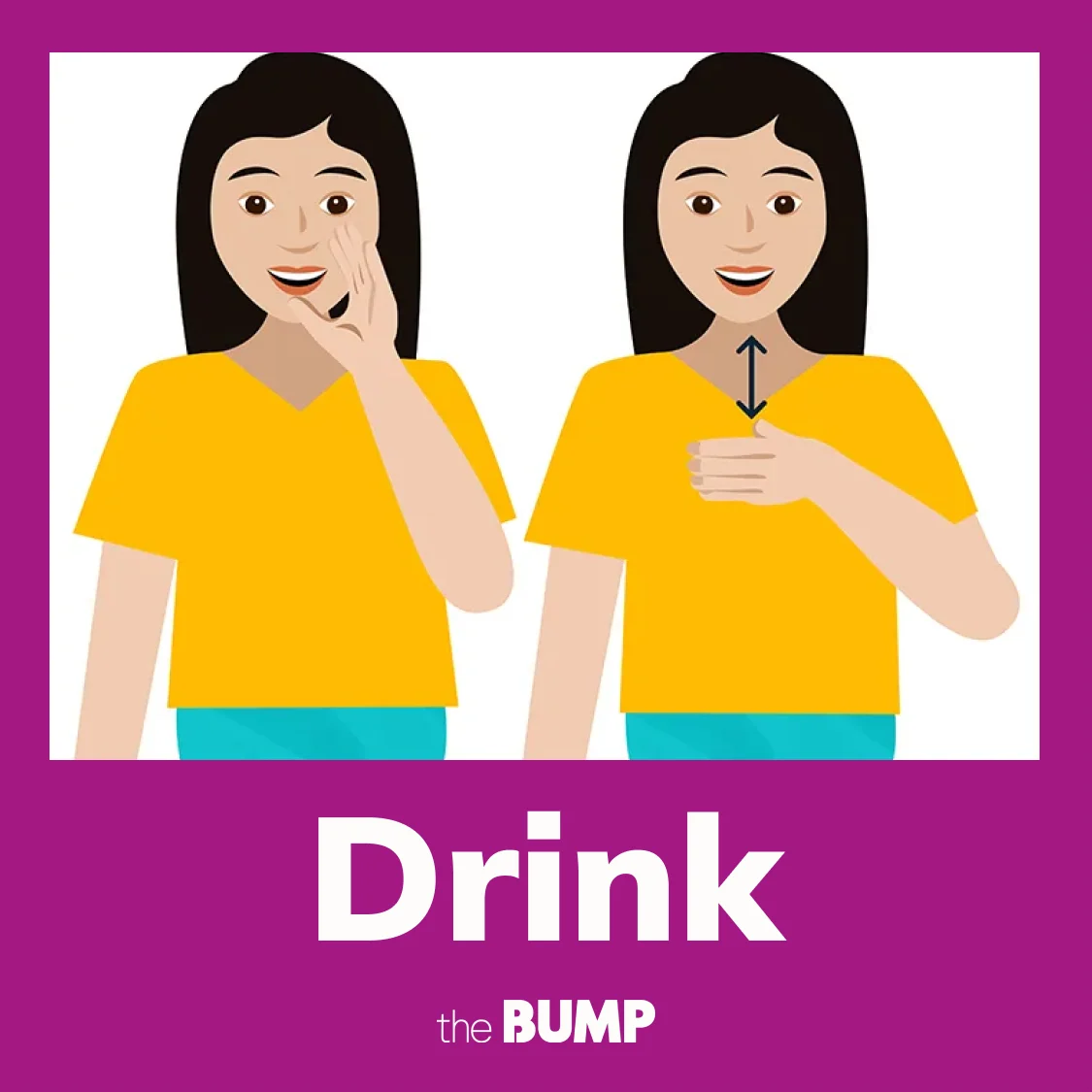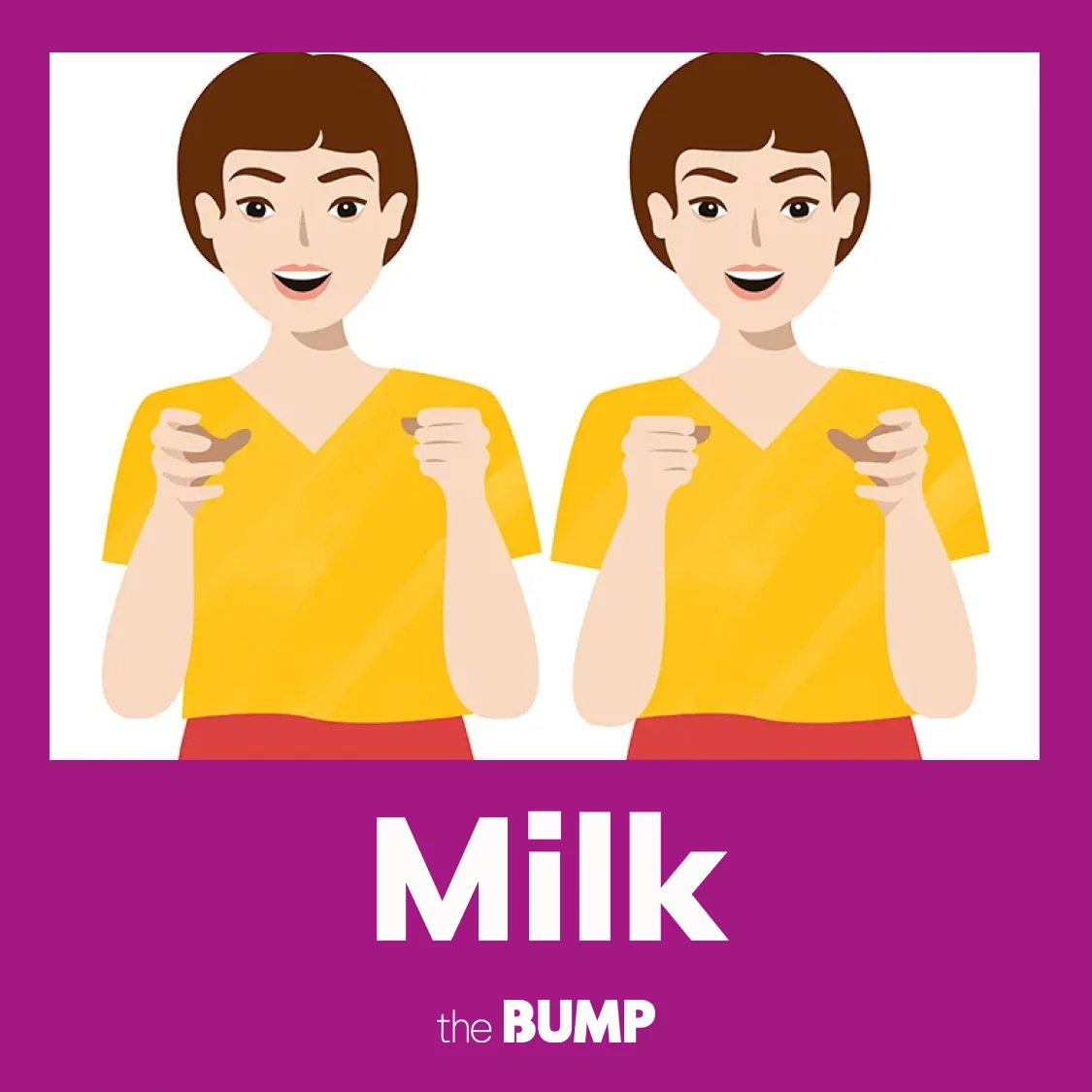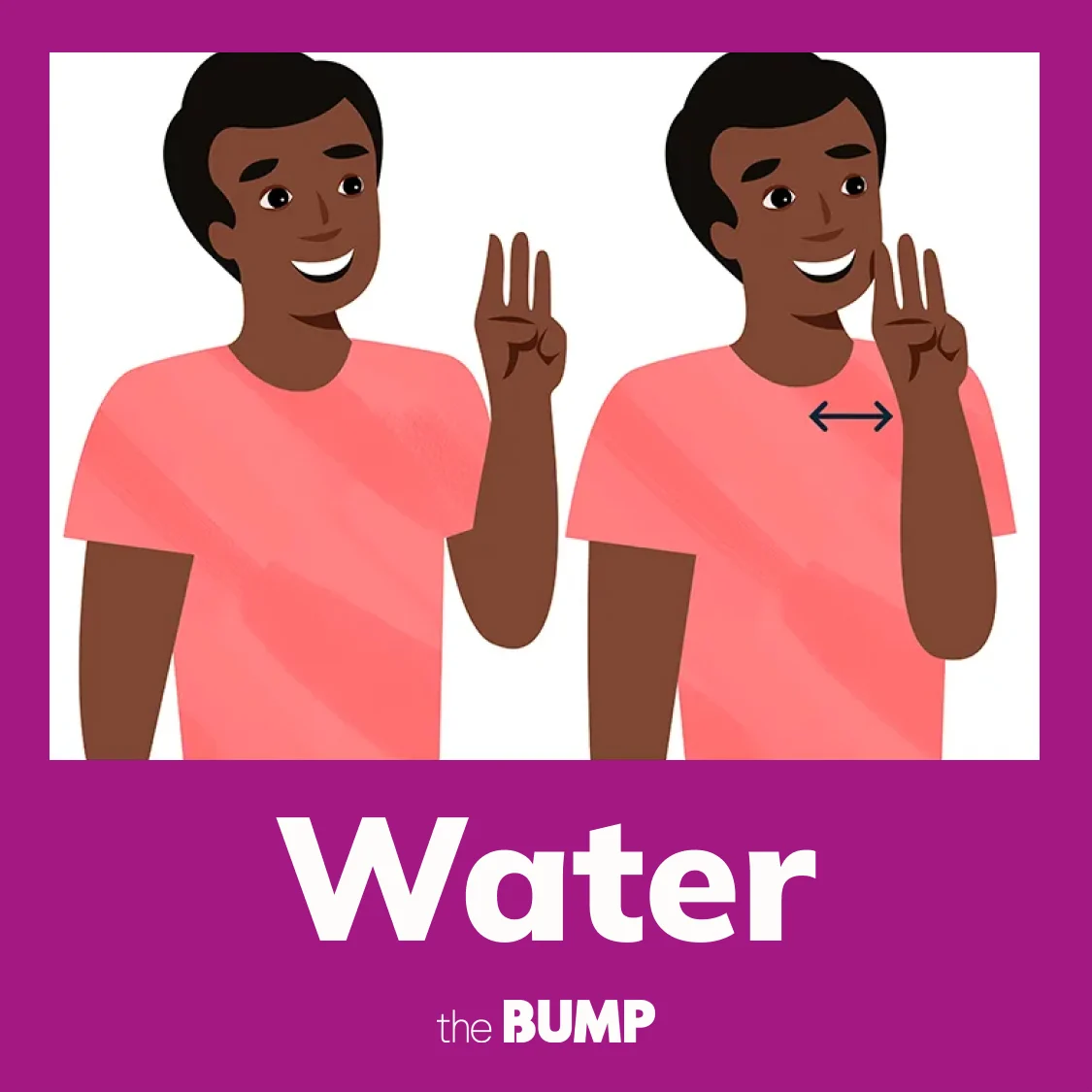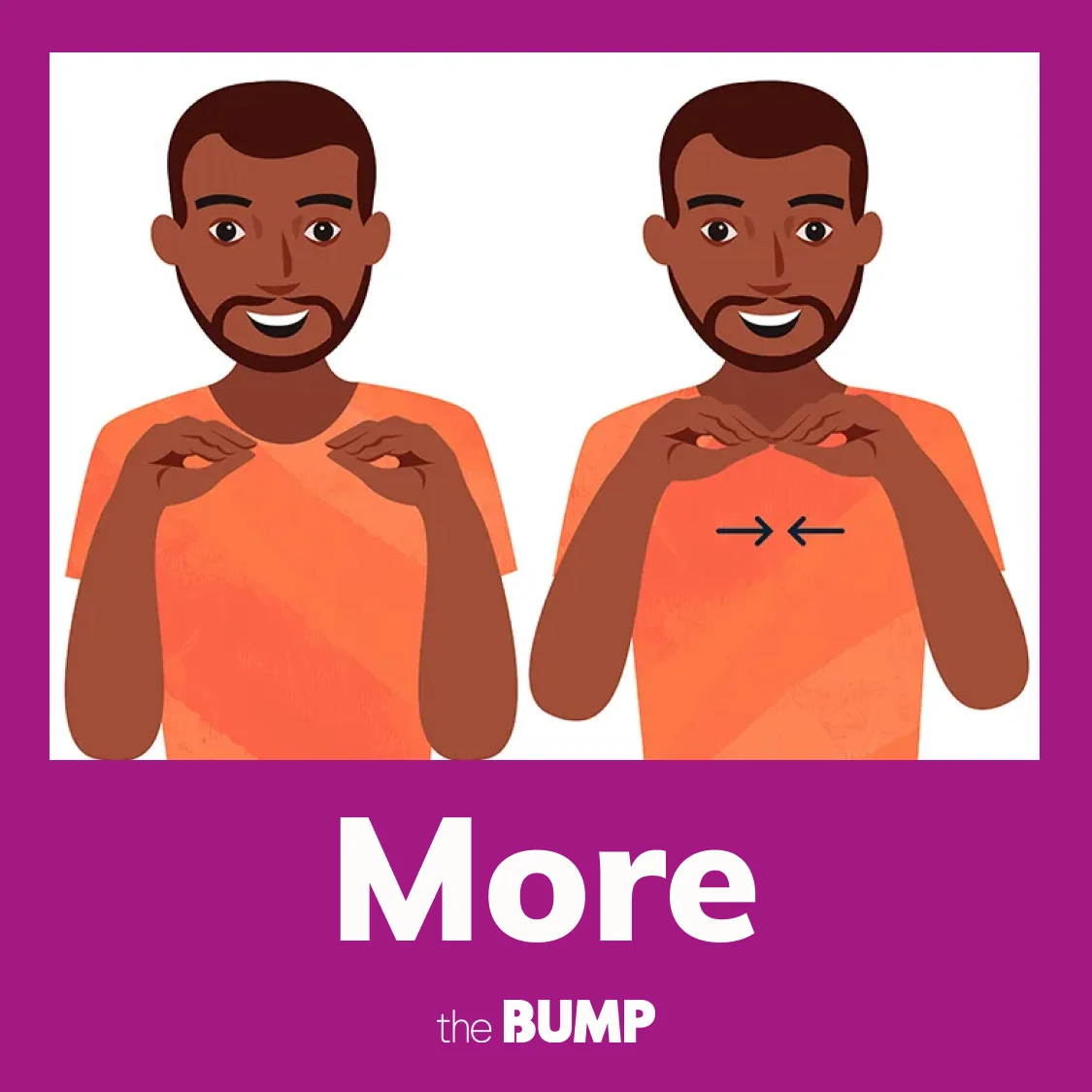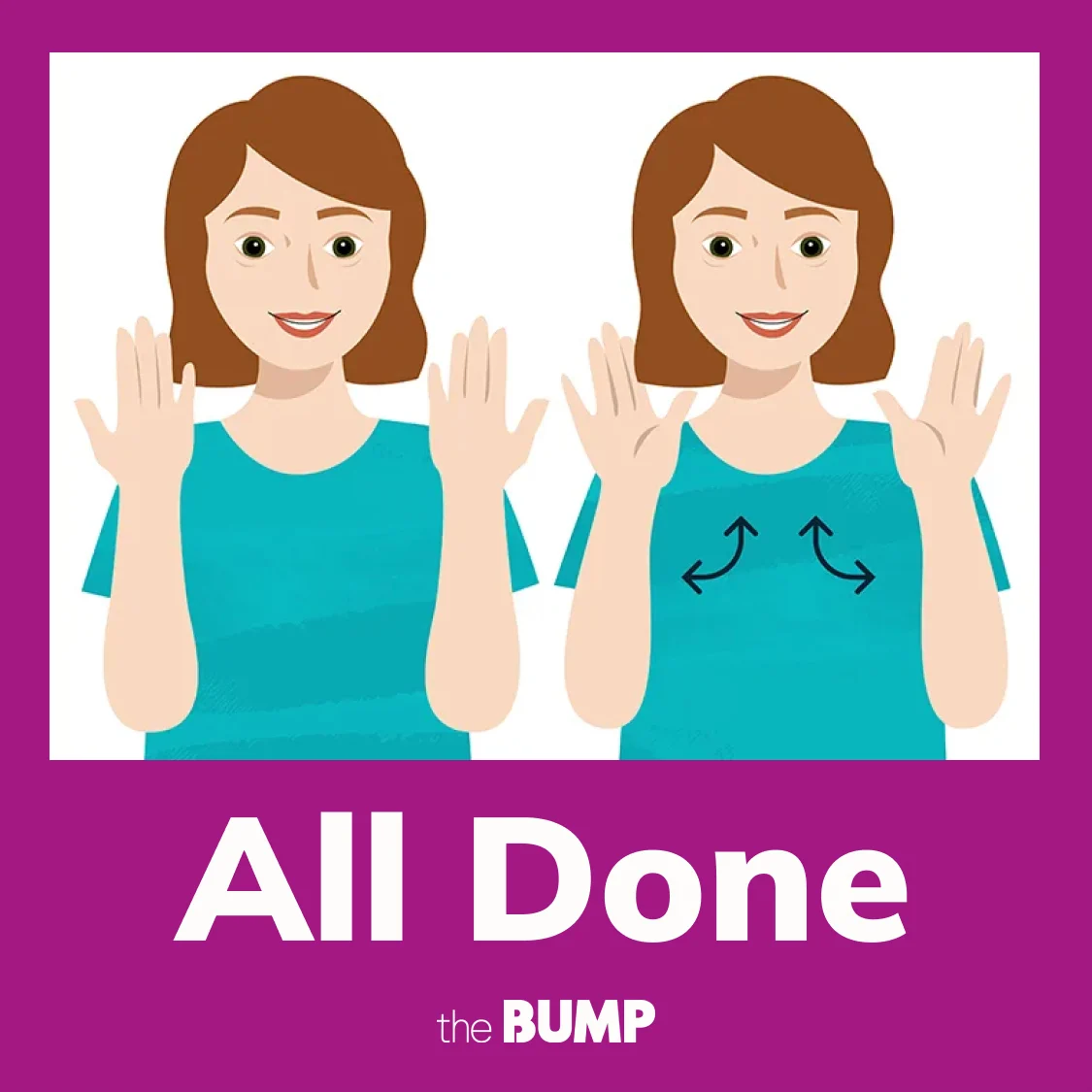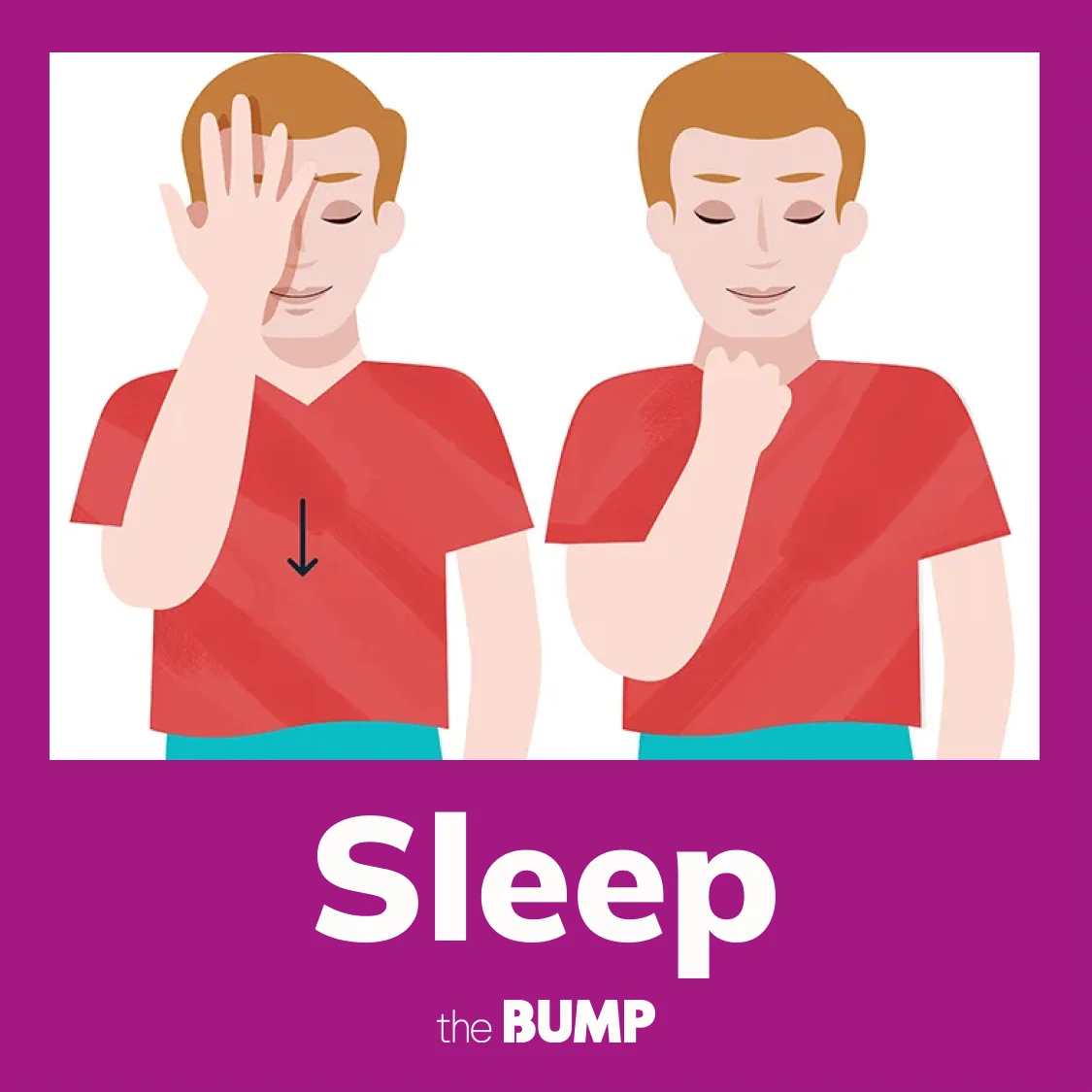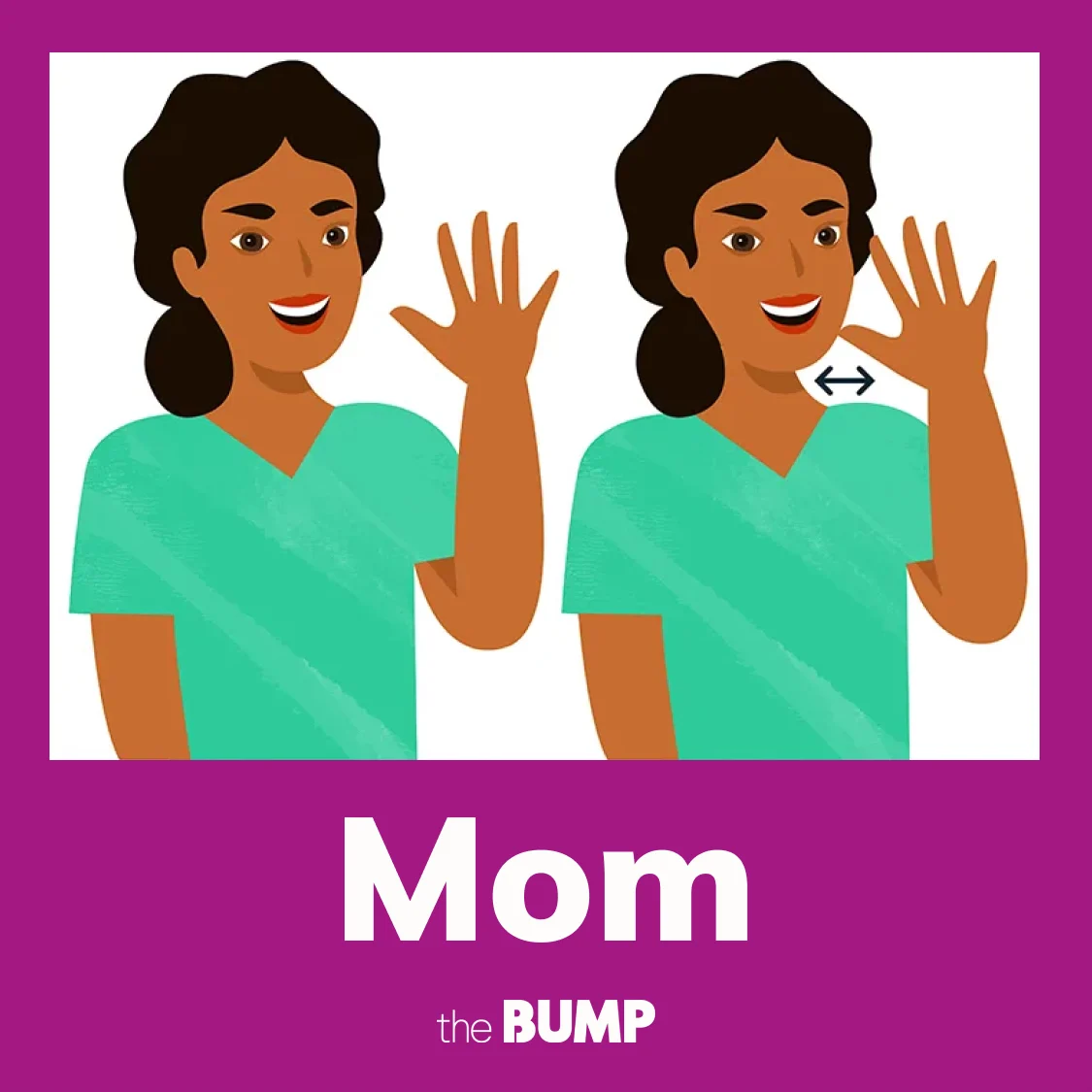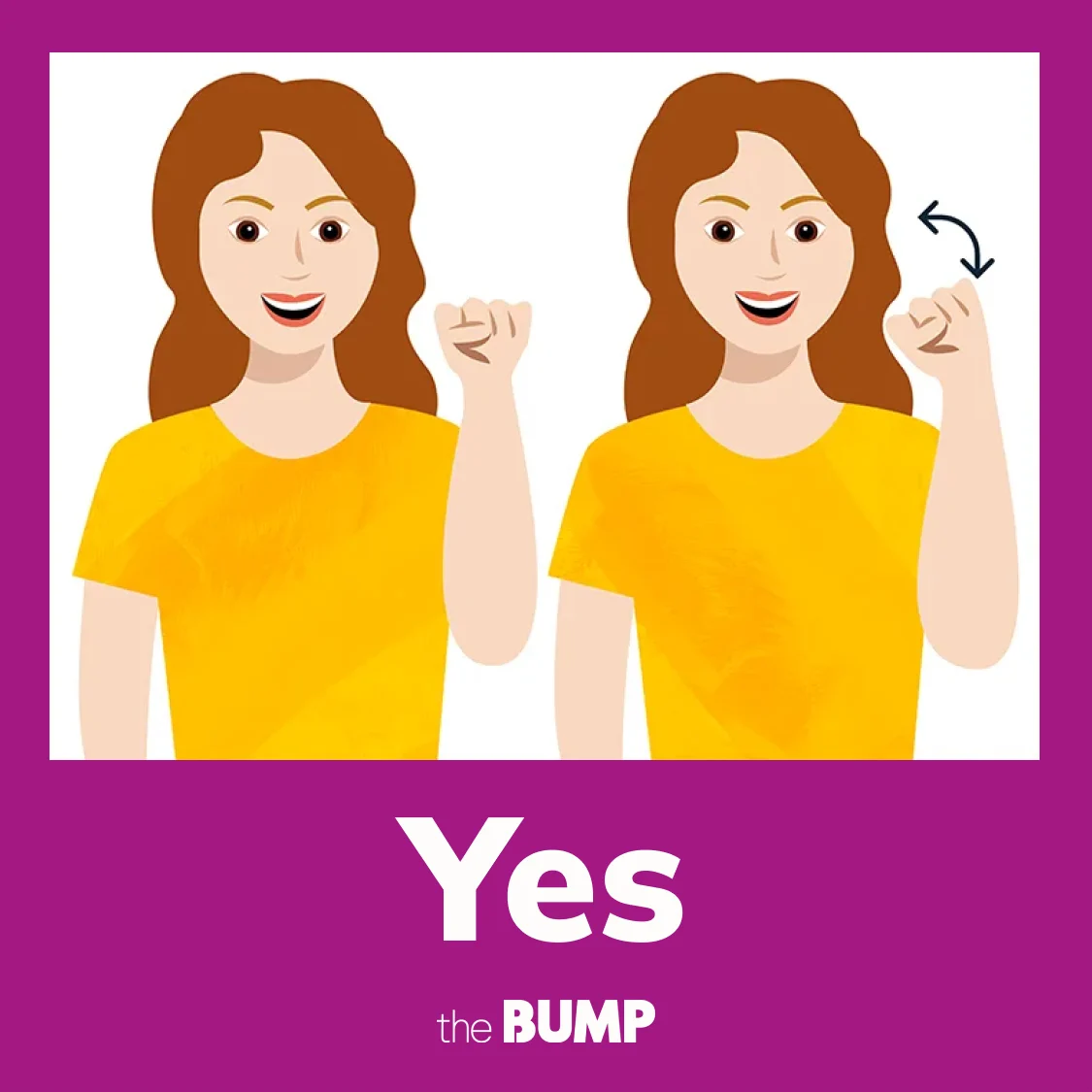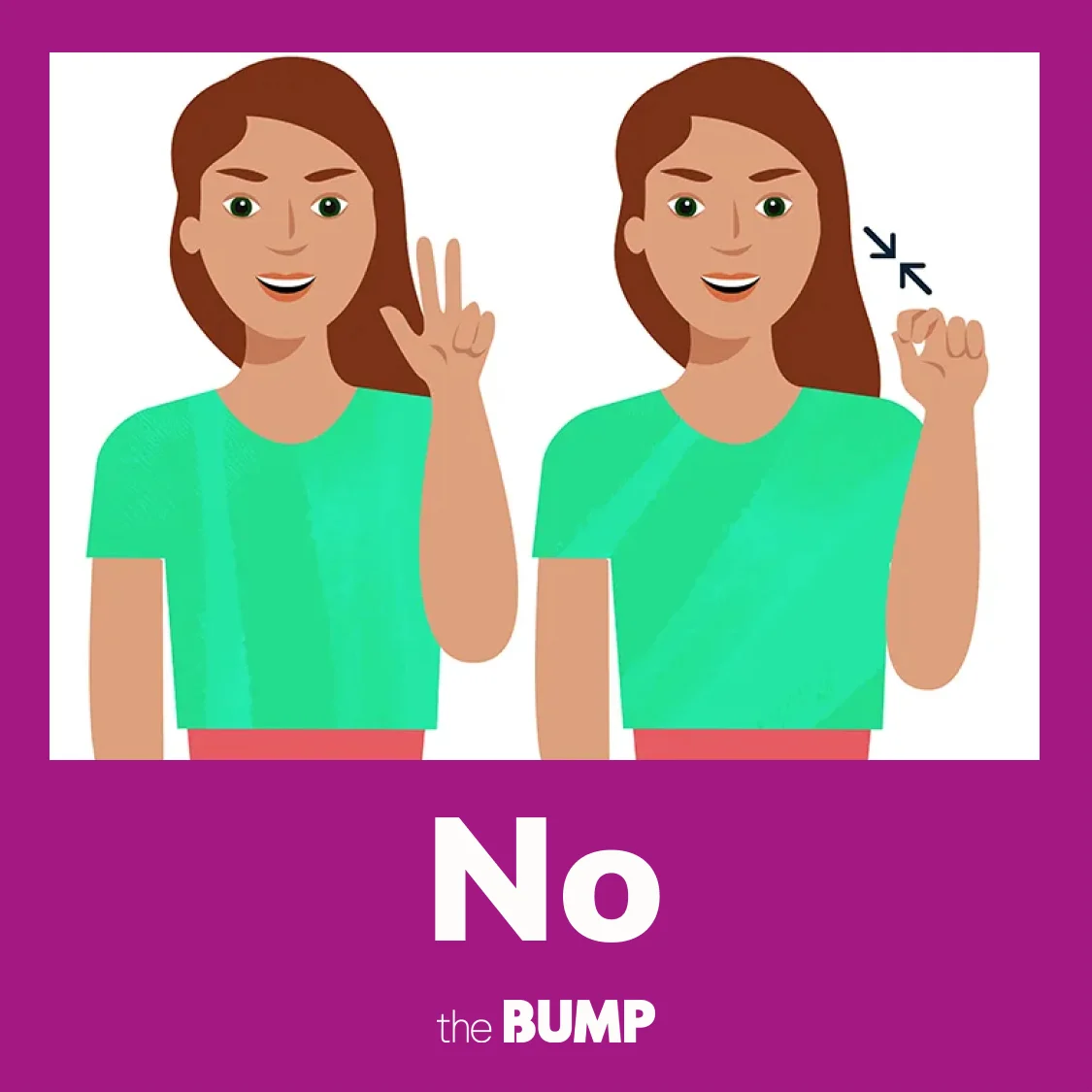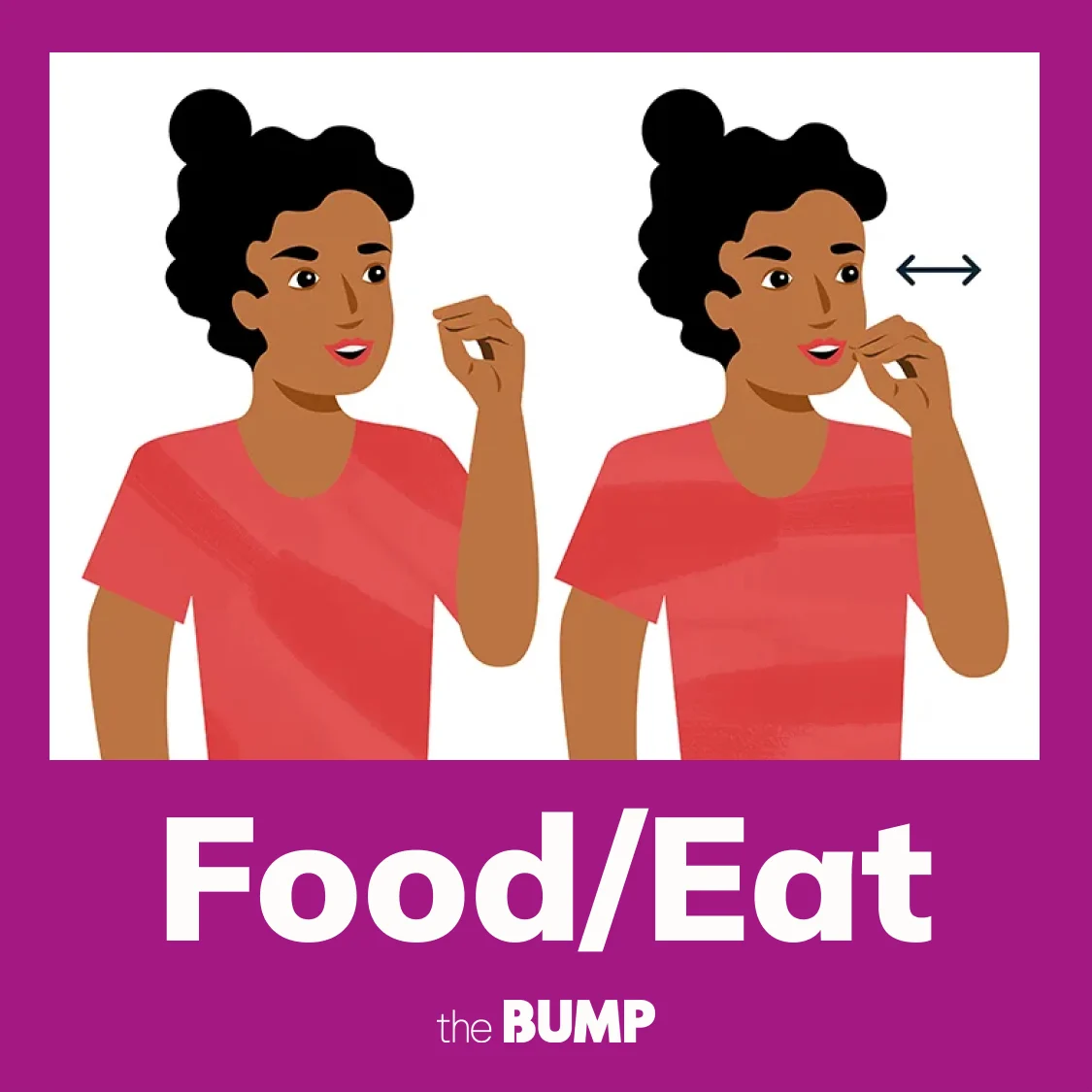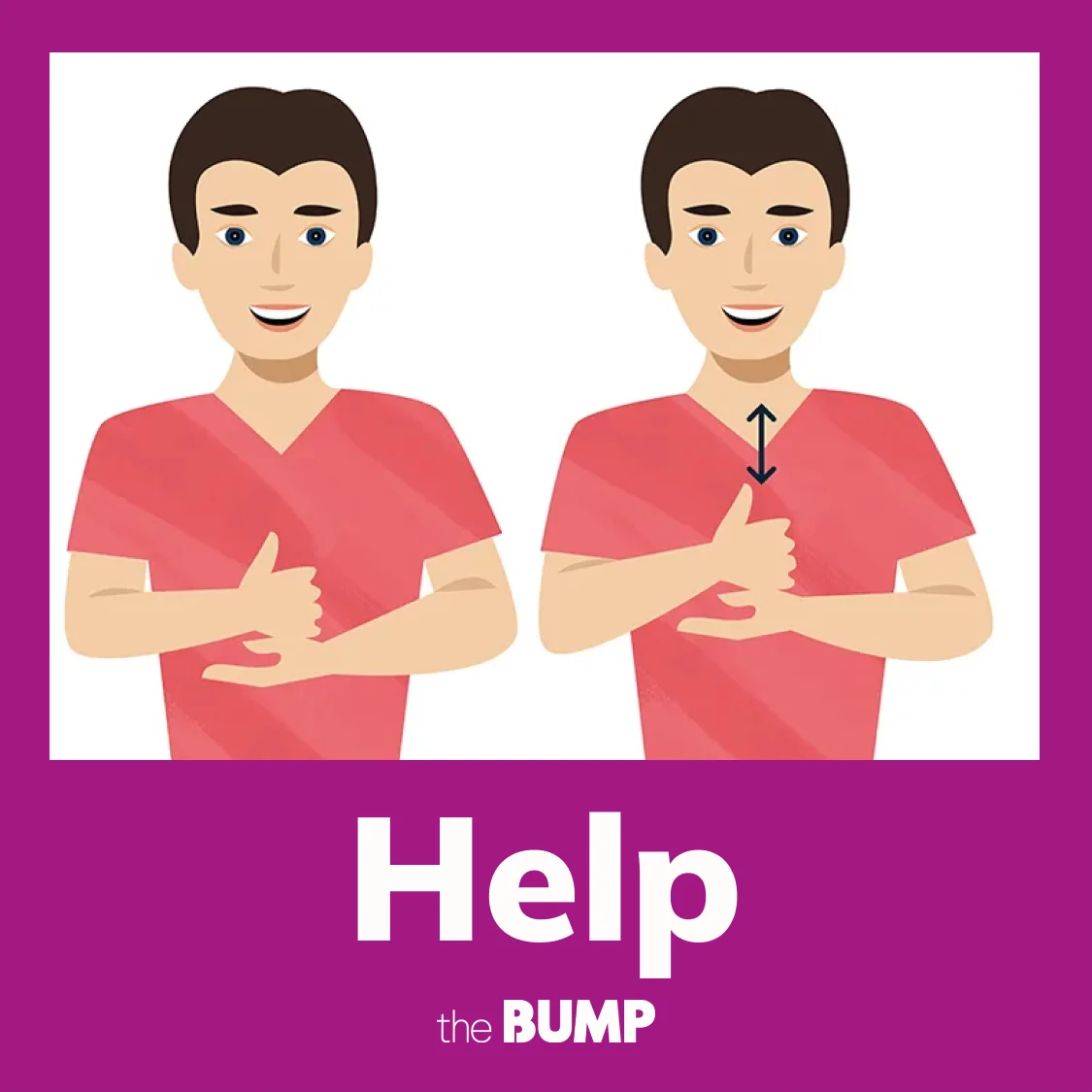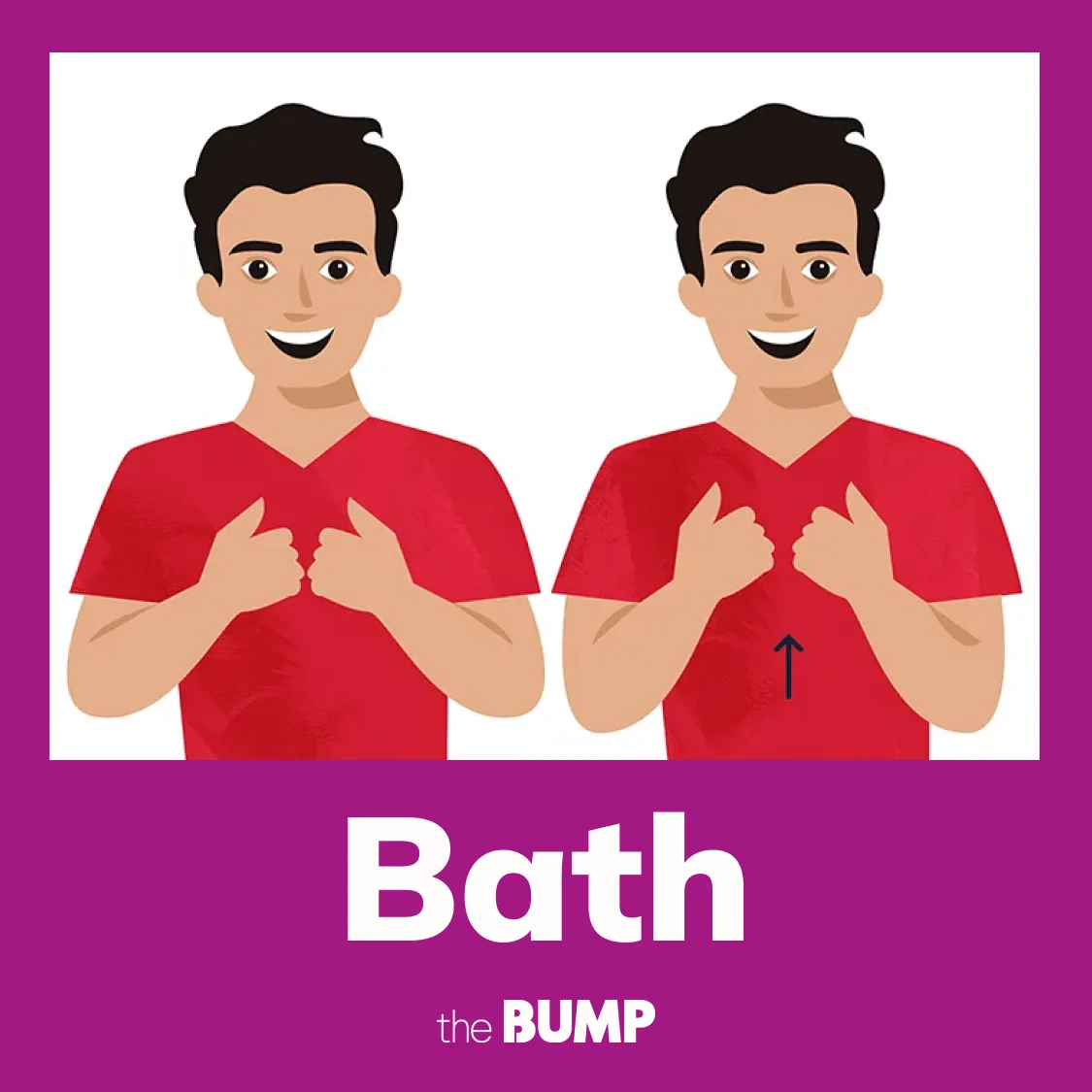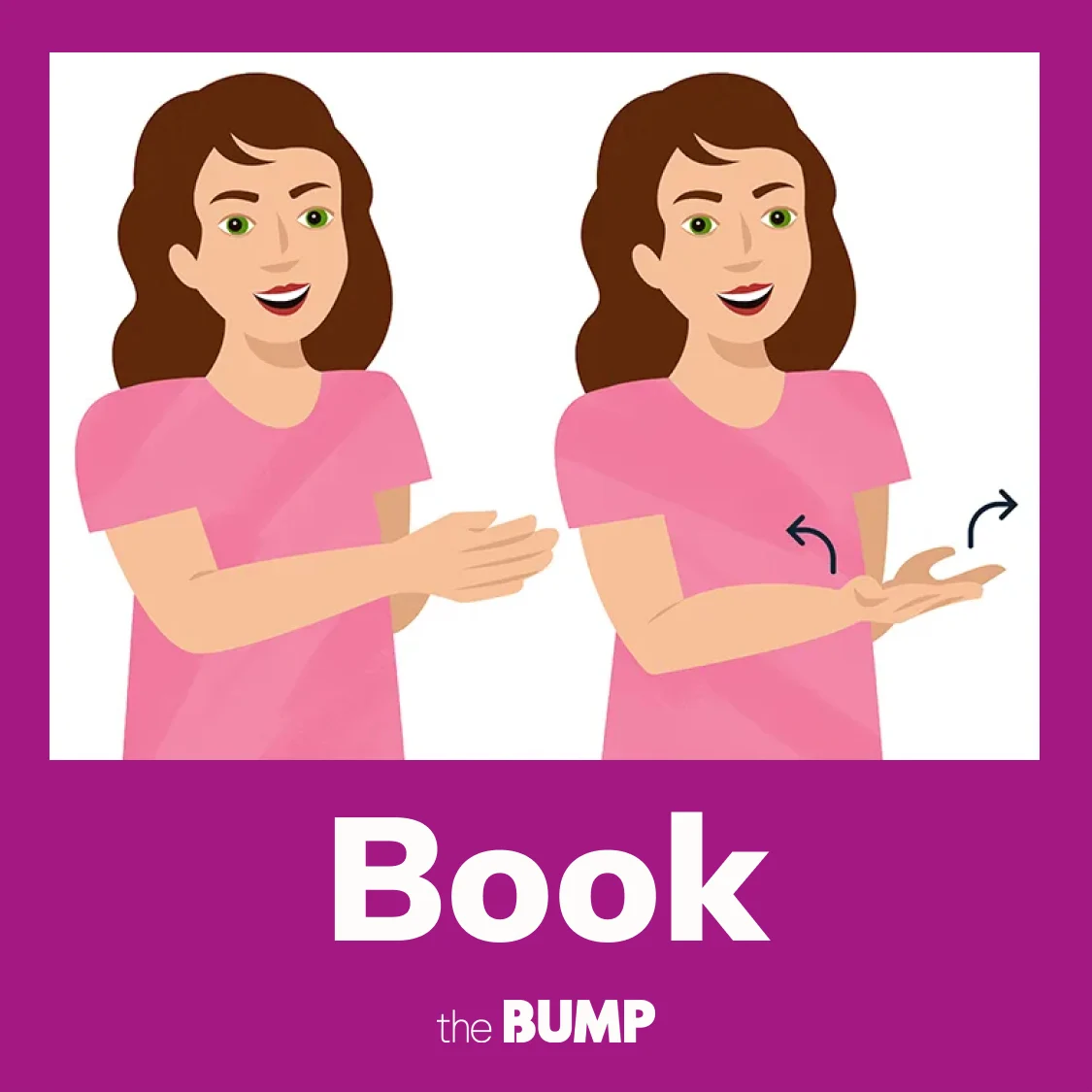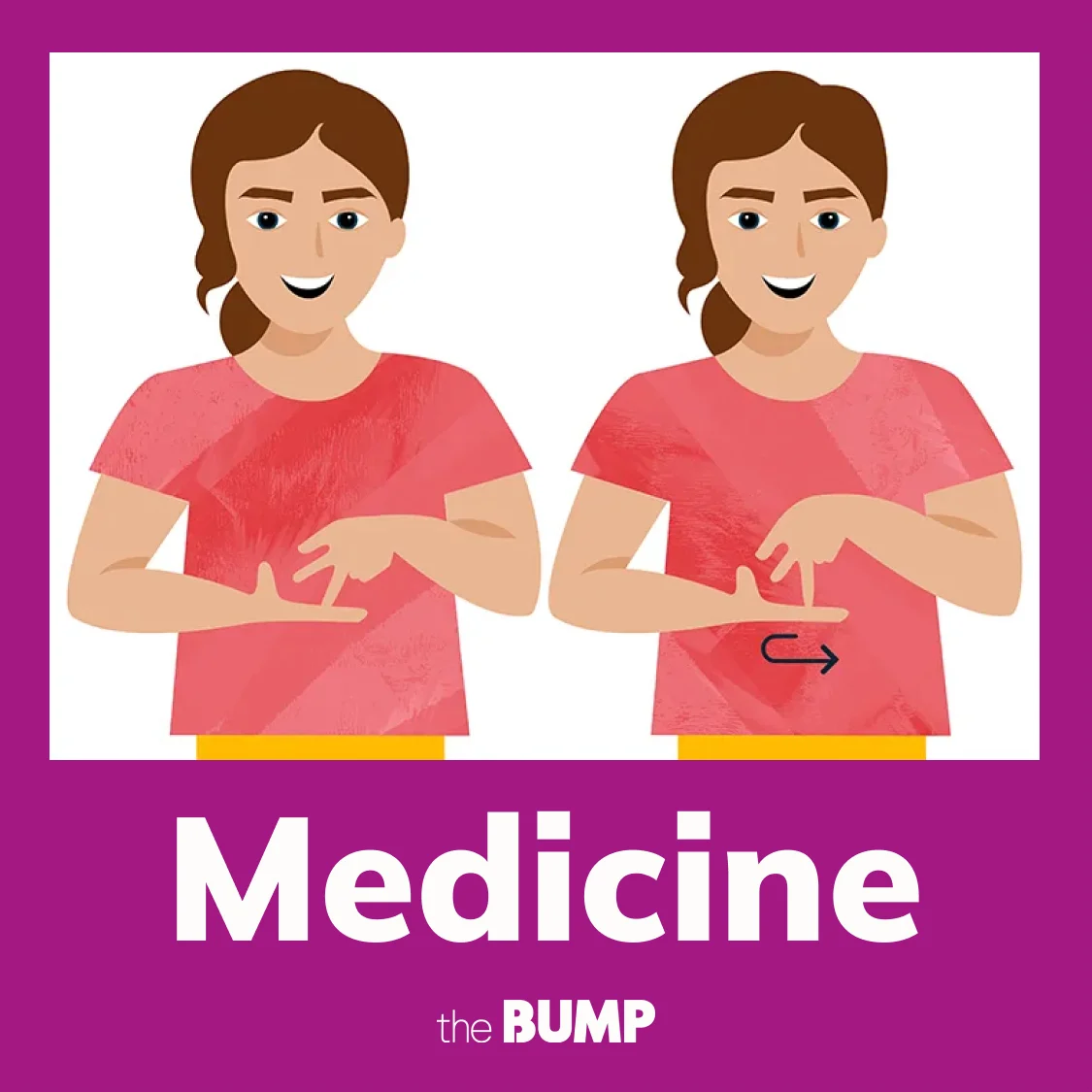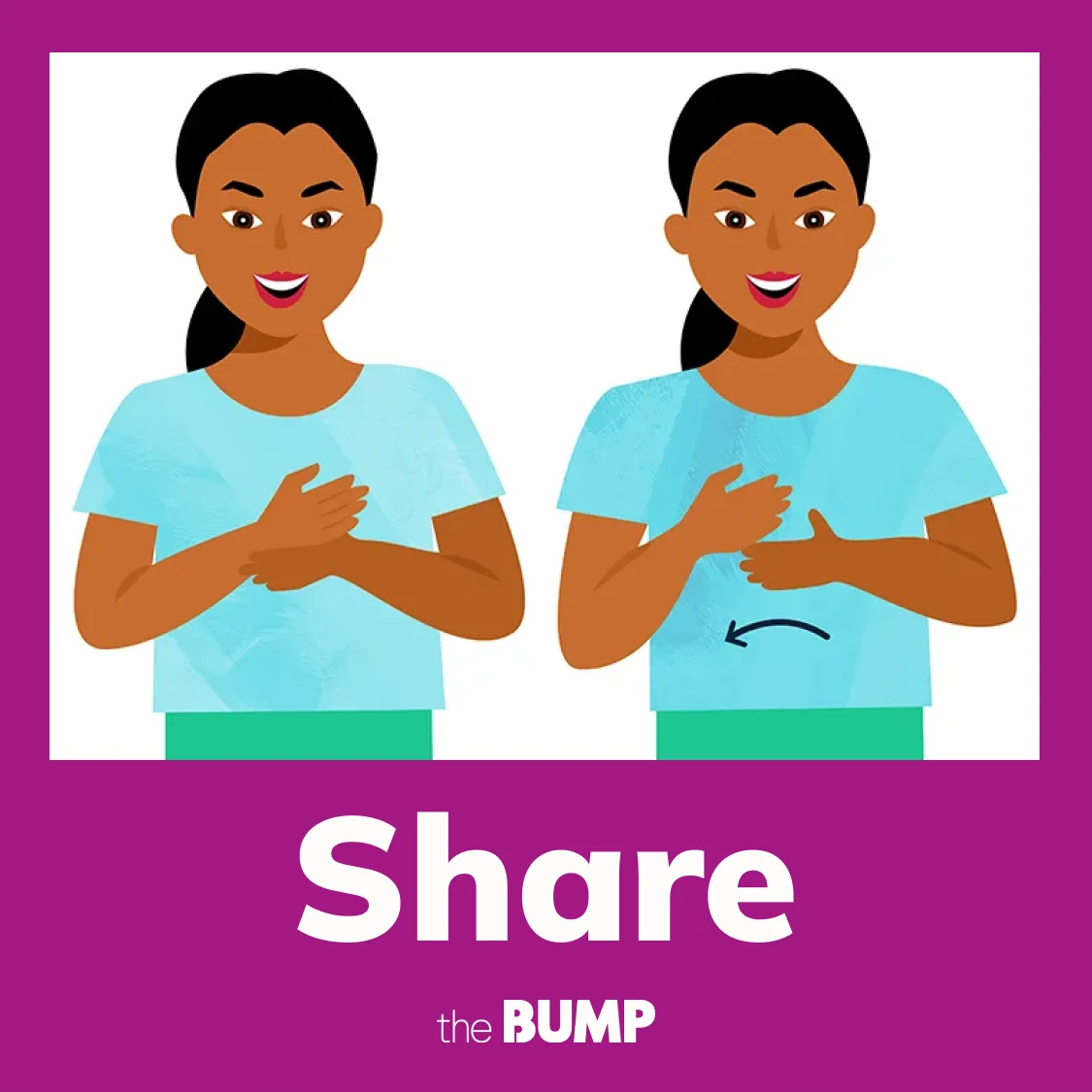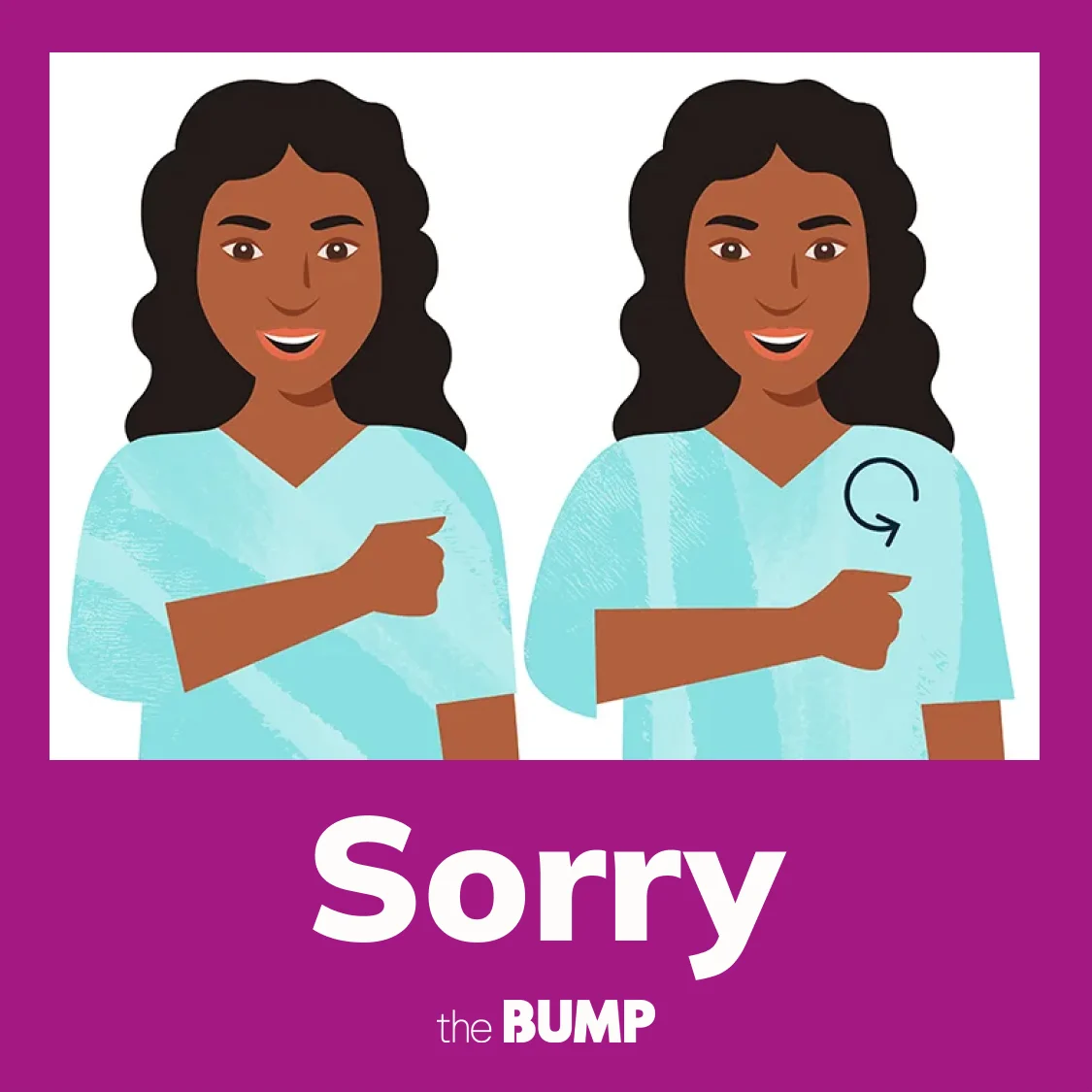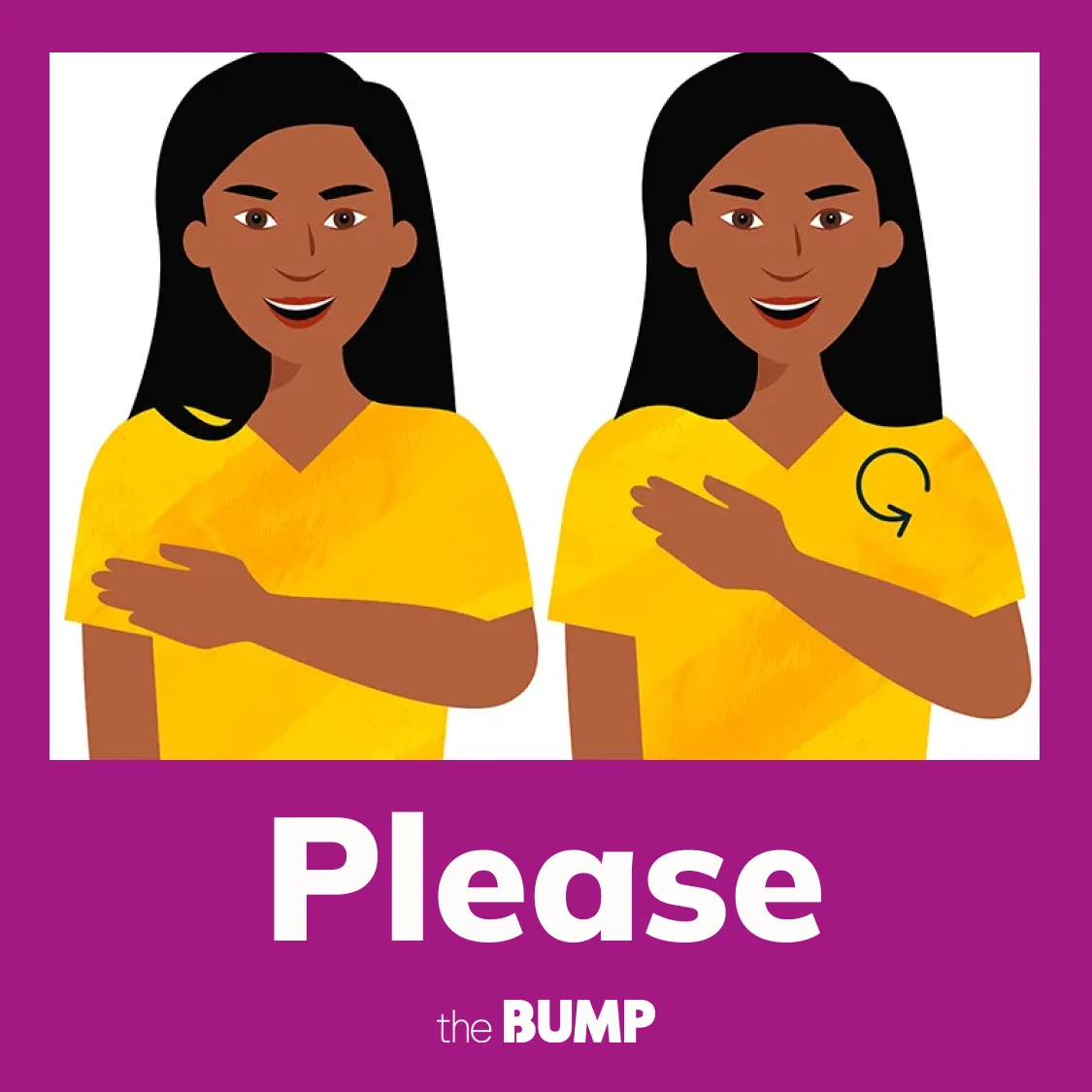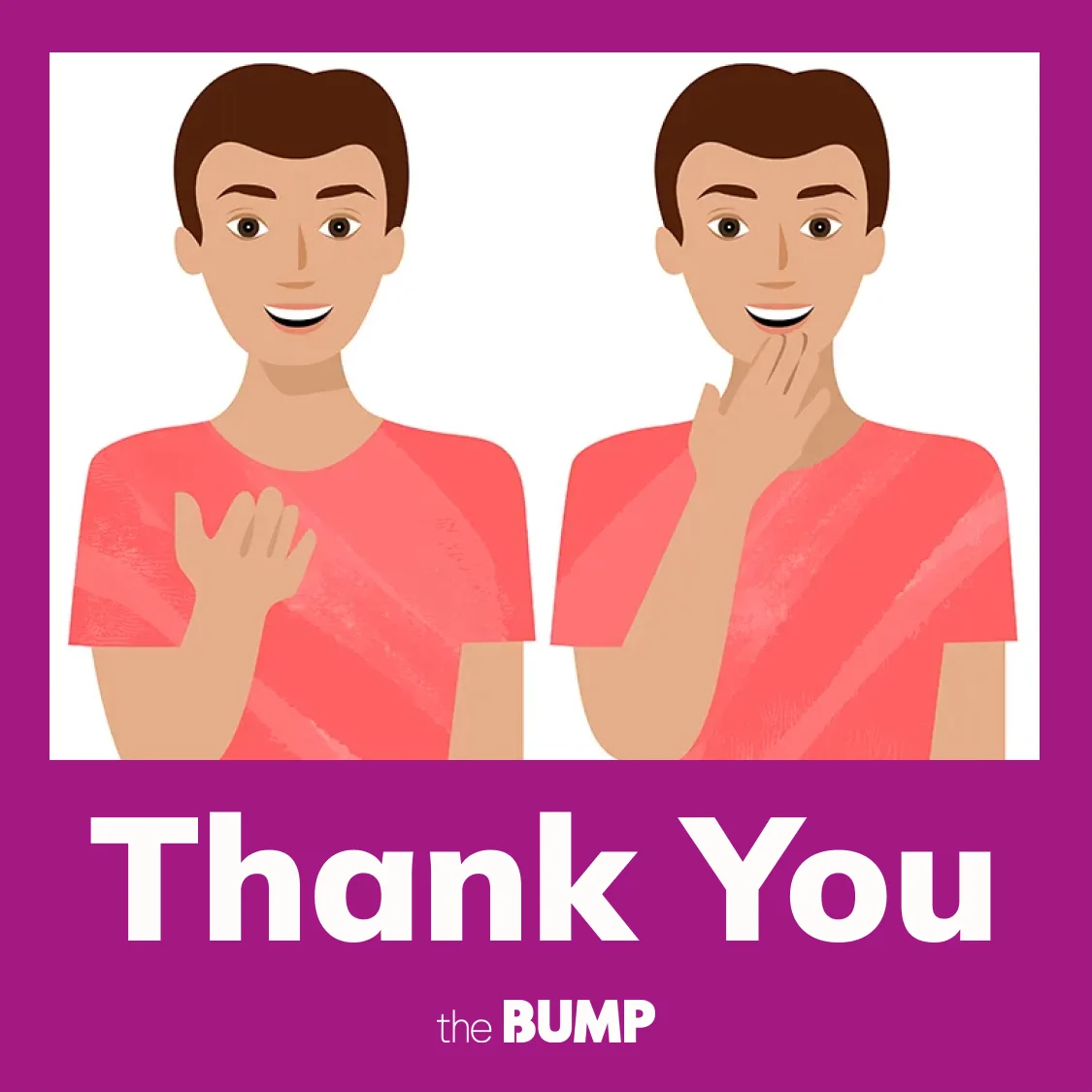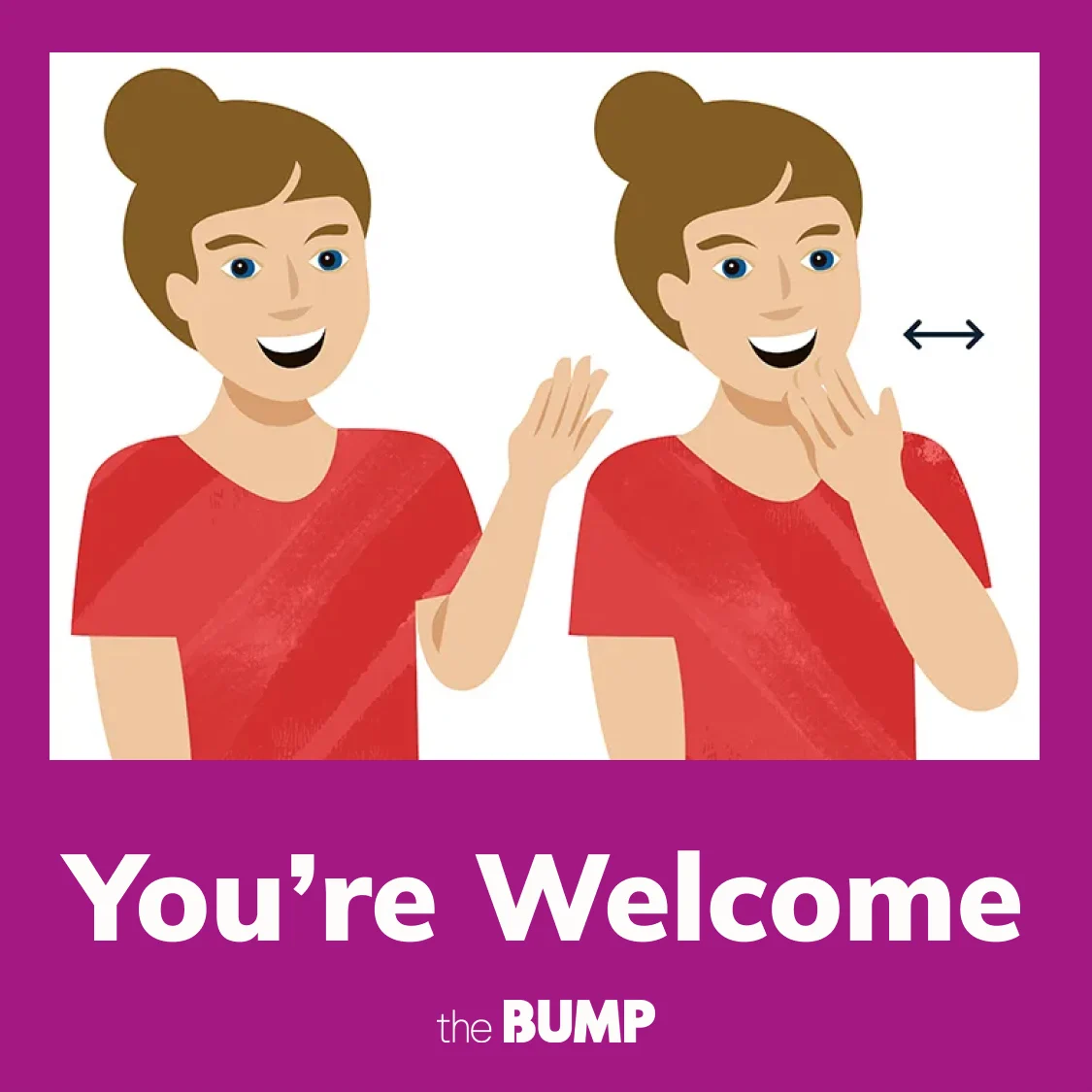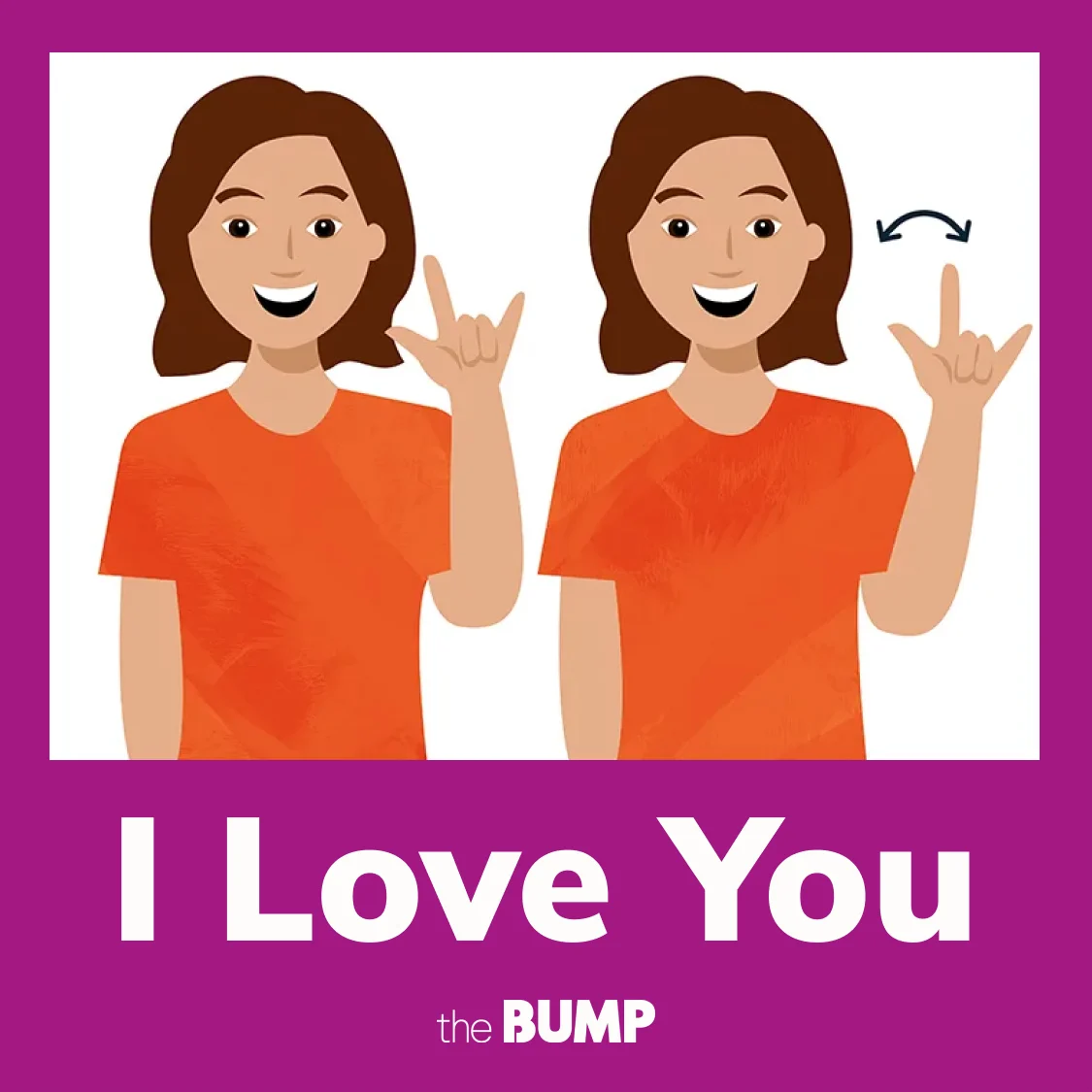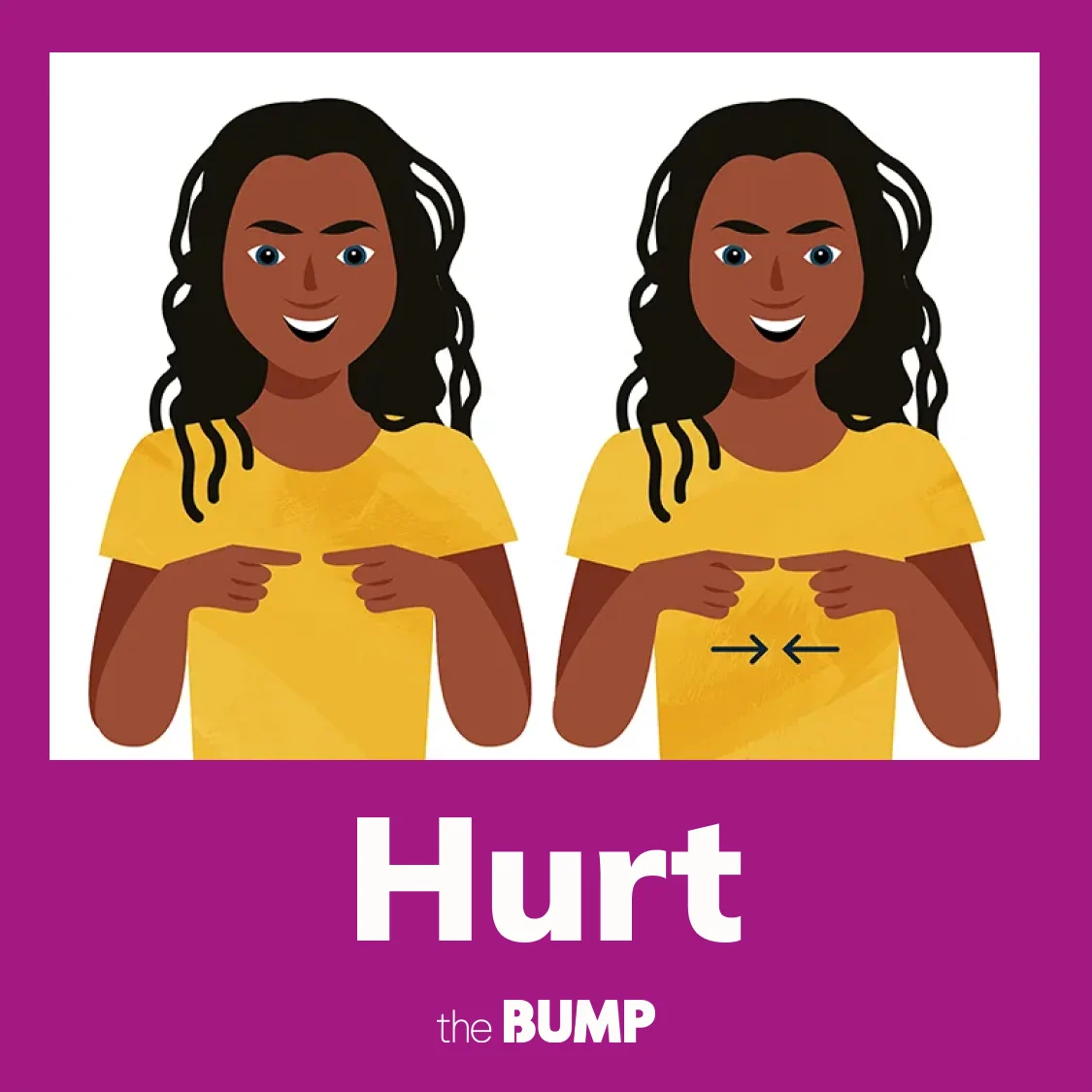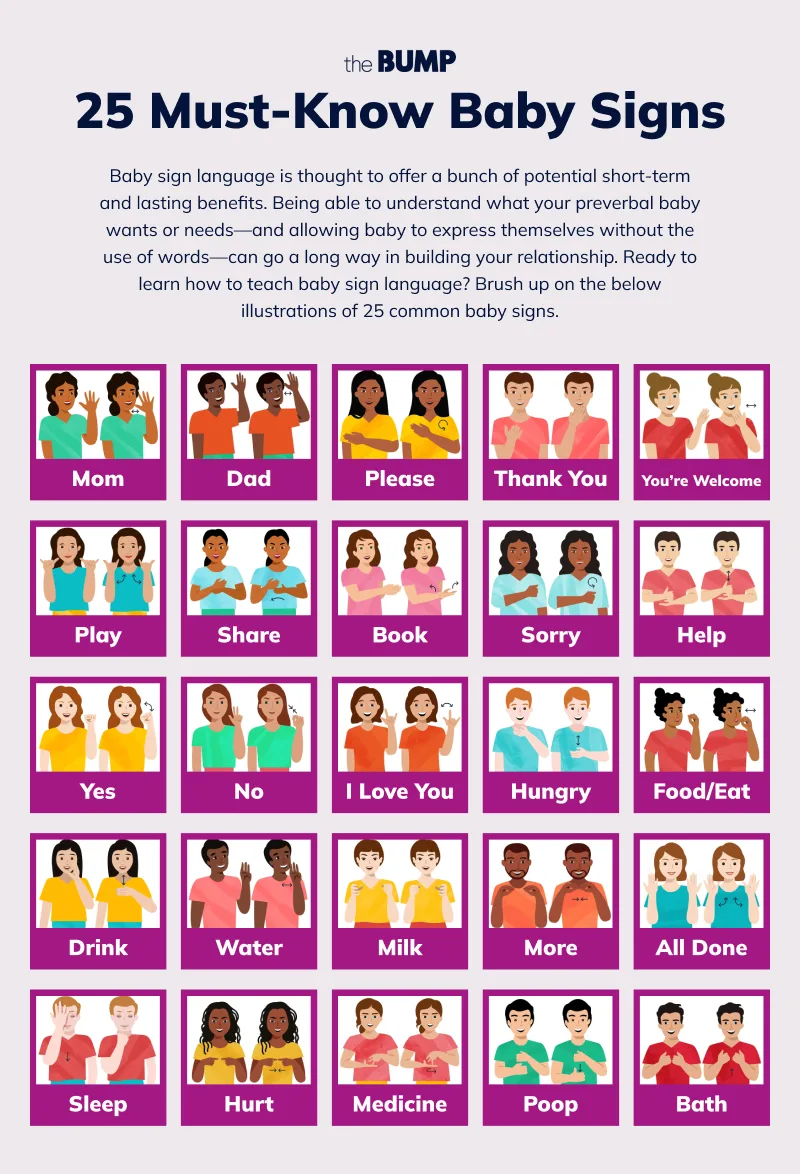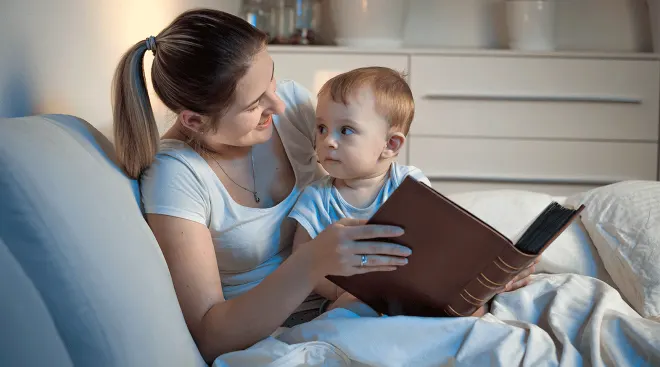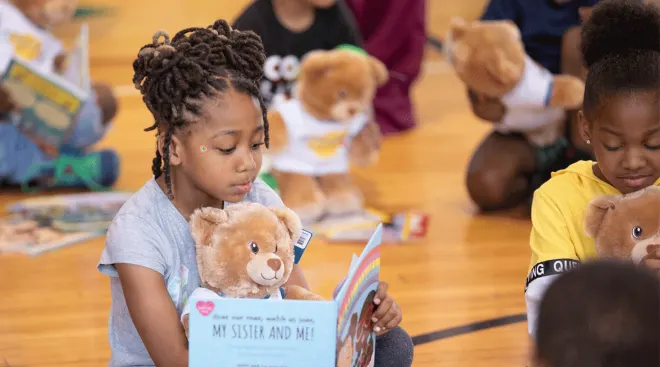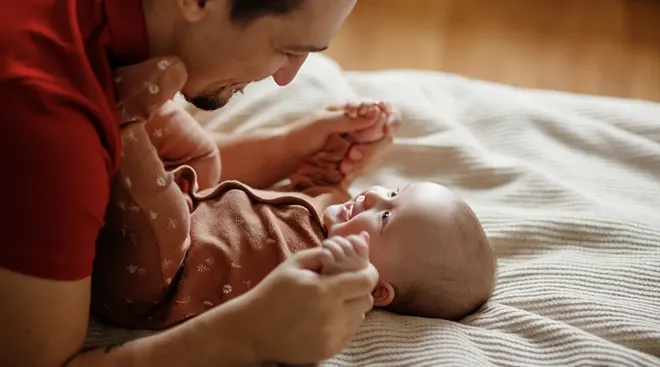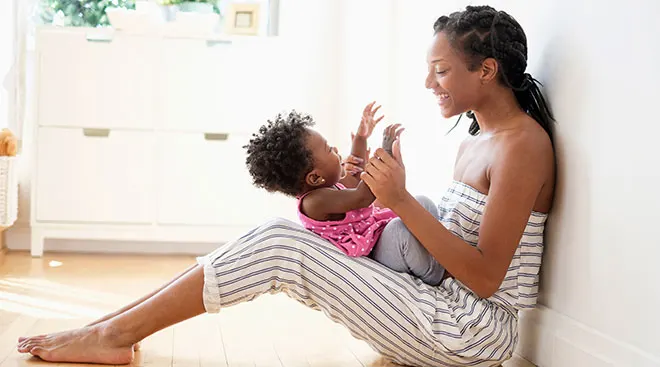How to Teach Baby 25 Key Words in Baby Sign Language
It can be hard to hear baby’s cries—and when they’re too young to speak, it can be hard to know exactly what your little one wants. Are they hungry? Tired? Do they need a diaper change? Not to mention, it’s probably just as frustrating for baby when they’re doing their best but can’t get their message across. In recent years, many parents and caregivers have been turning to baby sign language to help bridge the gap in communication with their preverbal infant. Here, learn from experts what sign language for babies is, its benefits, how to start teaching it and 25 common baby signs to know.
Baby sign language is a set of simple hand gestures and movements, otherwise known as signs, that correspond to common words you use with baby every day. It’s a helpful tool to enhance communication between hearing parents and babies who can hear but can’t yet talk. Sometimes the baby signs are the same as those used in American Sign Language (ASL), but not always. “Baby sign is not a technical sign language, such as ASL or BSL (British sign language), which are primarily used by the deaf community and are more complex, with grammar and sentence structure,” says Jann Fujimoto, CCC-SLP, a certified speech-language pathologist in Wisconsin. “It’s a looser version that uses just signs for individual words.”
Academics began making powerful observations about how hearing families could benefit from using baby sign language around 200 years ago, thanks to the work of linguist William Dwight Whitney in the 1800s. But it wasn’t until the 2000s that baby sign language became readily available to parents through workshops, classes and baby sign language books.
Baby sign language is thought to offer a bunch of potential short-term and lasting benefits. Being able to understand what your preverbal baby wants or needs—and allowing baby to express themselves without the use of words—can go a long way in building your relationship. Some of the possible benefits of baby sign language are:
Can baby sign language improve speech development?
Some experts believe baby sign language can offer a head start in language acquisition. In the late 1980s, Linda Acredolo, a University of California, Davis professor, and Susan Goodwyn, a professor at University of Southern California, Stanislaus, found that babies who used baby sign language actually learned verbal skills faster than those who didn’t sign. In a second study, they later checked in on those same children at age 8 and found that the babies who used signs scored higher on IQ tests than the non-signers.
Shira Fogel, a speech pathologist who founded Tiny Talkers, a baby sign language workshop program in Portland, Oregon, became a believer in the benefits of sign language for babies after witnessing her first child’s remarkable progress. Her daughter made her first sign (milk) at 5.5 months, knew more than 100 signs at 12 months and could speak in full sentences by the time she was 18 months old. Even the American Academy of Pediatrics believes baby sign language can help bridge the communication gap and has given it its stamp of approval.
It’s worth noting, though, that not all academics agree that baby sign language offers proven benefits—and the research is mixed. While some studies (including the ones conducted by Acredolo and Goodwyn) have found significant upsides to using sign language for babies, other studies haven’t unearthed any significant or long-term differences between children who learn baby sign language and those who don’t. So in general, the benefits of baby sign are considered theoretical.
And, as Jack Maypole, MD, associate clinical professor of pediatrics at Boston Medical Center, points out, some benefits of baby sign language may be overstated and overpromised by the vast offerings of baby sign products on the market. “While learning baby sign language may help hearing parents and children communicate better, the results won’t necessarily be transformative, so be wary of programs that promise to get your child into Harvard or have their first novel published by nursery school,” Maypole says.
So you’ve brushed up on the possible benefits of sign language for babies—but what about potential downsides? Since baby can begin to communicate using signs instead of spoken words, many parents wonder—does baby sign language delay speech? Fujimoto says no. If baby is developing at a healthy pace, baby sign just supplements their learning and gives them another way to express themselves. If you think baby might actually have a hearing impairment, don’t just rely on baby sign language as a solution, she adds. Talk to your pediatrician about your concerns and ask about referrals to an audiologist, who can perform the proper hearing tests and assessments.
If you’ve decided to give baby sign language a go, you may be wondering when to teach baby some signs. A good time to start is when baby is 4 to 6 months old, according to Fujimoto. As for how, there are many different approaches to teaching baby sign language, but generally, you can teach baby by saying a word like “milk,” while making the sign at the same time, and then giving baby the milk. “Don’t hold out the item as a prize and refuse to hand it over until your child makes the sign himself,” Fujimoto says. “Verbal reinforcement—by saying the word while also showing the sign—as well as consistency are key.”
As part of the consistency, you’ll want to use the signs every day for baby to truly understand them. While your little one likely won’t start making signs on their own until they’re about 6 to 9 months, eventually baby will start to make connections between the word, sign and item. Just like learning a foreign language, a preverbal baby is going to understand more than they can speak—or in this case, sign—at first.
For more resources, parents can turn to the many workshops, videos, books and apps available these days, all designed to help you teach sign language for babies. A typical class or workshop may teach parents 30 to 50 different signs you can then use with baby at your own pace. “Some families with older babies may learn best by singing along with a video, or attending a class together,” Fujimoto says. “Families should find the method that makes sense for them.”
When you’re ready to begin teaching baby sign language, you’ll need to decide which baby signs to start with. Fujimoto says to choose the words you and your family use the most on a day-to-day basis, like “more,” “please” and “milk.” Ready to learn how to teach baby sign language? Brush up on the below illustrations of 25 common baby signs.
“Hungry” in sign language
It’s important for baby to be able to communicate when they’re tummy feels empty—you know, before they get hangry. Teach them how to show you they’re “hungry” in sign language. You can make the sign for “hungry” by cupping your hand around your neck to make a C shape, then move your hand down from your neck to your stomach.
“Drink” in sign language
Want to learn how to sign “drink” in sign language? This one involves mimicking the action! Make a C shape with your hand, as if you were holding a cup, then move it to your mouth as if you were drinking from it.
“Milk” in sign language
Wondering how to teach baby sign language? It’s best to start with something baby knows, likes and wants—for example, milk. You can communicate the word “milk” in sign language, by making two fists, then extend your fingers and bring them back into fists.
“Water” in sign language
Teach baby how to request “water” in sign language, and you’ll always know when your little one wants their sippy cup. The sign for “water” is made by extending your three middle fingers so they’re pointing up, with your thumb and pinkie tucked down, and then tapping your index finger to your chin.
My oldest learned some baby sign language at daycare, and watching him get his needs met before he could verbally speak was just so gratifying. I was so appreciative of the teachers who helped him communicate before he could speak because otherwise he could get so agitated. “More” and “all done” became the most regularly used gestures in our home for a while—especially when he was eating something he liked (or didn’t like!). And then when he could say ‘maw,’ and he’d pair it with the gesture—swoon!”
“More” in sign language
Do you have trouble knowing if and when baby wants extra spoonfuls of their favorite puree? “More” is another important word for you and baby to learn. To express “more” in sign language, pinch your thumbs and fingers together on both hands, creating two O shapes, then tapping your fingertips together a few times.
“Done” in sign language
When baby is full, they want you to stop shoving that spoon toward their mouth. Teach them to let you know they’re “all done” without fussing by using the ASL sign for “finished.” Start with your hands up, palms facing toward you, and turn them until your palms face out.
“Play” in sign language
When it comes to baby sign language, the sign “play” certainly belongs in your arsenal. To communicate “play” in sign language, clench your fingers to your palms, leaving your thumbs and pinkies extended; then with palms facing you, twist your wrists back and forth.
“Sleep” in sign language
Nobody likes having a fussy, sleep-deprived baby on their hands, so it’s a good idea to practice “sleep” in sign language. Hold your hand over your forehead with your fingers spread apart, then draw your hand down over your face until your fingers and thumb come together to touch your chin. Even babies who resist nap time may whip this one out when they’re especially exhausted.
“Mom” in sign language
Your little one will want to know how to address their favorite people in baby sign language. To sign “mom,” simply spread your fingers apart, then with your pinkie facing forward, tap your thumb to your chin.
“Dad” in sign language
As another one of baby’s favorite people, Dad will want in on the fun too! You can make the sign for “dad” by spreading your fingers apart, then with your pinkie facing forward, tap your thumb to your forehead.
“Poop” in sign language
Everybody does it, so you might as well learn to sign it! If you want to indicate “poop” in sign language, clench both hands into fists and stack them on top of each other, with the thumb of the bottom hand tucked inside the upper fist. Then, pull your bottom hand down from the upper hand, leaving your thumb extended. Next time baby soils their diaper, they’ll let you know—before you even smell it.
“Yes” in sign language
Another easy and important sign to learn is “yes.” Enthusiastically nodding your head is great, but this sign gives baby yet another communication tool. Intuitively, “yes” in sign language looks just like a nodding hand. Make a fist and then, folding at your wrist, bob your fist up and down.
“No” in sign language
Again, shaking your head works, but this sign helps reiterate the point. To express “no” in sign language, extend your thumb, index and middle fingers, then quickly snap them together.
“Food” in sign language
Instead of signing “hungry,” baby may want to ask for “food.” This sign can also mean “eat.” Communicate “food” in sign language by flattening your fingers on top of your thumb and then bringing your fingertips to your mouth.
“Help” in sign language
When learning and teaching baby sign language, be sure to review the sign for “help.” This can be useful to baby in so many different situations; plus, being able to ask for support from a parent or caregiver can help reduce any frustration a baby may feel. If you want to communicate “help” in sign language, simply make a fist with one hand, with the thumb extended, and place it over your other hand, which is extended flat. Then move both hands up together.
“Bath” in sign language
Want to tell baby it’s bath time? Express ‘“bath” in sign language by making two fists, then moving them up and down in front of your chest (as if you were scrubbing yourself clean).
“Book” in sign language
Storytime is the best time! Use your hands to say “book” in sign language; clasp your palms together with your thumbs facing up, then hinge open your hands, keeping your pinkies together (as if you were cracking open a book).
“Medicine” in sign language
The sign for “medicine” is made by placing your middle finger into the palm of your opposite hand and twisting.
“Share” in sign language
To sign “share,” extend one hand flat, with your thumb pointing up. Then, run your other hand back and forth along the top of your extended fingers.
“Sorry” in sign language
Teach baby to show empathy and express feelings before they know how to do it verbally. The sign for “sorry” is made by rubbing a fisted hand in a circle over your chest.
We never formally taught baby sign language, but our son did pick up some while watching Ms. Rachel! His favorite sign remains 'Please!' (rub your hand against your chest in circles). To this day (he's 3 now), he’ll ask for something (typically ice cream) and I will say, 'What do you say?' Then he signs, 'Please!' It's so cute and hard to resist
“Please” in sign language
Manners matter. Teach baby to ask for things politely from the get-go. To sign “please,” extend your fingers and thumb out, then rub your flattened palm against your chest in circles.
“Thank you” in sign language
Nothing is sweeter than watching your little one express gratitude. And they’ll appreciate it when you show them the same respect and courtesy right back. To sign “thank you,” straighten your thumb and fingers, then bring your fingers to your chin and pull them away.
“You’re welcome” in sign language
The sign for “you’re welcome” is the same as the sign for “thank you”—flatten your hand, bring your fingers to your chin and pull them back.
“I love you” in sign language
This is one sign you’re going to both want to use all the time. To sign “I love you,” extend your thumb, index and pinkie fingers (but keep your ring and middle fingers down). Hold your hand out with the palm facing away and rotate your hand side to side.
“Hurt” in sign language
The baby sign for “hurt” is done by clenching both hands into fists, then extending your index fingers and touching them together.
Here, you can see 25 of the most common signs, all in one comprehensive baby sign language chart.
Frequently Asked Questions
Is symbolic gesture the same as baby sign language?
They’re related but not the same, says Katie Sterbenz, cofounder of Wee Talkers, a pediatric speech pathology brand that teaches parents of babies and toddlers how to support their child's language and communication. “But we definitely recommend using both gestures and signs with baby. Gestures are actually really important when it comes to language development,” she adds. “Baby sign is a system of gestures and simple signs that are easier for babies and toddlers to copy and say than words,” Sterbenz says.
Can you start baby sign language too early?
“It’s never too early to start introducing simple signs to baby,” says Carly Tulloch, co-founder of Wee Talkers. “If you have the ability to choose, 6 to 9 months is a really nice time to start, but there’s also not a wrong time to start.”
Can baby sign language demotivate baby to learn to speak?
Rest assured it won’t make your little one lose the motivation to speak verbally! “Babies and toddlers do the best they can with the abilities they have,” says Sterbenz. “Because the movements needed to produce signs are much simpler than the complex fine motor movements required to speak, they usually imitate these signs before spoken words. And when spoken words are just as easy as signs, they’ll do it!”
Don’t look at sign language as a delayant; rather, think of it as a step in the right direction! “When you’re incorporating sign language, always model spoken language with the sign and encourage any and all vocalizations! Even if it doesn’t match up with the word perfectly,” suggests Sterbenz.
Is baby sign language the starting point for ASL?
“ASL is something very different from the type of sign language we’re encouraging you to use with your babies,” explains Tulloch. “ASL is its own language with its own grammatical structure… Baby sign, on the other hand, is used by hearing parents to help their child communicate faster or more effectively."
Now that you know the basics of how to teach baby sign language, begin practicing a few words you think you’ll use most frequently at home. Your little one will love having a special way to communicate their wants and needs with you. What’s more, having the ability to express your feelings to each other will help strengthen your bond. It’s a win-win!
Please note: The Bump and the materials and information it contains are not intended to, and do not constitute, medical or other health advice or diagnosis and should not be used as such. You should always consult with a qualified physician or health professional about your specific circumstances.
Plus, more from The Bump:
Jann Fujimoto, CCC-SLP, is a certified speech-language pathologist in Wisconsin. With 17 years of experience, she has worked in birth-to-three programs, pre-schools and schools, hospitals, skilled nursing facilities and outpatient clinics. She received her MS in communication disorders from the University of Texas at Dallas.
Jack Maypole, MD, is an associate clinical professor of pediatrics at Boston Medical Center and a pediatrician with over two decades of experience. He received his bachelor’s degree from Yale University and his medical degree from Yale University School of Medicine.
Katie Sterbenz, MS, CCC-SLP, is the co-founder of Wee Talkers,a pediatric speech pathology brand that teaches parents of babies and toddlers how to support their child's language and communication with online courses. She holds a master’s degree from Arizona State University.
Carly Tulloch, MA, RSLP, CCC-SLP, is the co- founder of Wee Talkers, a pediatric speech pathology brand that teaches parents of babies and toddlers how to support their child's language and communication with online courses. She holds a master’s degree from California State University.
New Directions for Childhood and Adolescent Development, Encouraging symbolic gestures: A new perspective on the relationship between gesture and speech, December 2013
International Conference on Infant Studies, The Longterm Impact of Symbolic Gesturing During Infancy on IQ at Age 8, July 2000
Healthy Children (American Academy of Pediatrics), Baby Sign Language: These Hands Were Made for Talking, January 2022
Journal of Applied Behavior Analysis, Enhancing Early Communication through Infant Sign Training, February 2013
Baby Signs, The Science Behind the Signing Proven Benefits from Two Decades of Scientific Research
First Language, How HANDy are baby signs? A commentary on a systematic review of the impact of gestural communication on typically developing, hearing infants under the age of 36 months, December 2014
Learn how we ensure the accuracy of our content through our editorial and medical review process.
Navigate forward to interact with the calendar and select a date. Press the question mark key to get the keyboard shortcuts for changing dates.


































